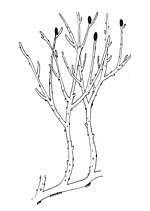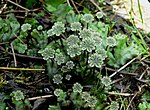 | Vascular plants (from Latin vasculum 'duct'), also called tracheophytes (/trəˈkiː.əˌfaɪts/) or collectively tracheophyta (/trəˈkiː.əfaɪtə/; from Ancient... 24 KB (1,972 words) - 22:58, 27 March 2024 |
 | Non-vascular plants are plants without a vascular system consisting of xylem and phloem. Instead, they may possess simpler tissues that have specialized... 6 KB (660 words) - 23:38, 25 March 2024 |
 | Vascular tissue is a complex conducting tissue, formed of more than one cell type, found in vascular plants. The primary components of vascular tissue... 4 KB (459 words) - 22:53, 31 March 2024 |
 | Pteridophyte (redirect from Seedless vascular plant) A pteridophyte is a vascular plant (with xylem and phloem) that reproduces by means of spores. Because pteridophytes produce neither flowers nor seeds... 17 KB (1,655 words) - 22:53, 2 April 2024 |
 | Botany (redirect from Plant biology) species of land plants of which some 391,000 species are vascular plants (including approximately 369,000 species of flowering plants), and approximately... 136 KB (14,353 words) - 10:36, 19 April 2024 |
 | Embryophyte (redirect from Land plant) non-vascular land plants, namely the mosses (Bryophyta), hornworts (Anthocerotophyta), and liverworts (Marchantiophyta), are relatively small plants, often... 41 KB (3,855 words) - 06:10, 19 April 2024 |
 | The vascular cambium is the main growth tissue in the stems and roots of many plants, specifically in dicots such as buttercups and oak trees, gymnosperms... 8 KB (945 words) - 10:34, 24 April 2024 |
 | Royal Botanic Gardens, Kew (redirect from World Checklist of Vascular Plants) seed plant families. WCSP is widely used, and most authoritative web resources on plants use it as their basis. The World Checklist of Vascular Plants (WCVP)... 16 KB (1,586 words) - 02:23, 23 March 2024 |
 | Flora of Australia (redirect from Australian native plant) Australia comprises a vast assemblage of plant species estimated to over 21,000 vascular and 14,000 non-vascular plants, 250,000 species of fungi and over 3... 44 KB (4,673 words) - 05:47, 10 April 2024 |
 | Root (redirect from Plant roots) In vascular plants, the roots are the organs of a plant that are modified to provide anchorage for the plant and take in water and nutrients into the... 49 KB (5,794 words) - 03:38, 27 April 2024 |
 | Fern (section Fern-like flowering plants) The ferns (Polypodiopsida or Polypodiophyta) are a group of vascular plants (plants with xylem and phloem) that reproduce via spores and have neither... 59 KB (5,649 words) - 21:27, 7 April 2024 |
 | A vascular bundle is a part of the transport system in vascular plants. The transport itself happens in the stem, which exists in two forms: xylem and... 4 KB (344 words) - 02:23, 11 November 2023 |
 | necessary complexity to evolve. Trilete spores similar to those of vascular plants appear soon afterwards, in Upper Ordovician rocks about 455 million... 135 KB (16,791 words) - 13:45, 25 April 2024 |
 | Moss (redirect from Moss (plant)) Mosses are small, non-vascular flowerless plants in the taxonomic division Bryophyta (/braɪˈɒfətə/, /ˌbraɪ.əˈfaɪtə/) sensu stricto. Bryophyta (sensu lato... 61 KB (6,981 words) - 01:13, 18 April 2024 |
Stele (biology) (redirect from Vascular cylinder) In a vascular plant, the stele is the central part of the root or stem containing the tissues derived from the procambium. These include vascular tissue... 7 KB (926 words) - 04:41, 10 July 2023 |
 | Xylem (category Plant anatomy) Xylem is one of the two types of transport tissue in vascular plants, the other being phloem. The basic function of the xylem is to transport water from... 54 KB (6,747 words) - 11:00, 14 March 2024 |
 | List of model organisms (section Vascular plants) moellendorffii, remnant of an ancient lineage of vascular plants that is key to understanding the evolution of land plants. It has a small genome size (~110Mb) and... 45 KB (4,555 words) - 21:44, 26 April 2024 |
 | Arbuscular mycorrhiza (redirect from Vascular arbuscular mycorrhiza) (AM fungi, or AMF) penetrates the cortical cells of the roots of a vascular plant forming arbuscules. Arbuscular mycorrhiza is a type of endomycorrhiza... 95 KB (11,428 words) - 20:35, 23 April 2024 |
 | are terrestrial vascular plants; like the gymnosperms, they have roots, stems, leaves, and seeds. They differ from other seed plants in several ways.... 78 KB (6,060 words) - 18:55, 25 April 2024 |
 | Phloem (category Plant anatomy) Phloem (/ˈfloʊ.əm/, FLOH-əm) is the living tissue in vascular plants that transports the soluble organic compounds made during photosynthesis and known... 19 KB (2,330 words) - 10:27, 23 April 2024 |
been predictable on the basis of examination of the separate parts." A vascular plant begins from a single celled zygote, formed by fertilisation of an egg... 26 KB (3,245 words) - 23:38, 22 April 2024 |
 | Rhynia (category Prehistoric plant genera) Devonian vascular plants. Rhynia gwynne-vaughanii was the sporophyte generation of a vascular, axial, free-sporing diplohaplontic embryophytic land plant of... 10 KB (1,032 words) - 21:58, 5 October 2022 |
 | Electro-osmosis (section Vascular plant biology) drag water molecules from one side (anode) to the other (cathode). In vascular plant biology, electro-osmosis is also used as an alternative or supplemental... 16 KB (1,963 words) - 07:29, 2 March 2024 |
 | Flora of Madagascar (section Vascular plants) than 12,000 species of plants, as well as a poorly known number of fungi and algae. Around 83% of Madagascar's vascular plants are found only on the island... 91 KB (8,334 words) - 18:48, 5 March 2024 |





